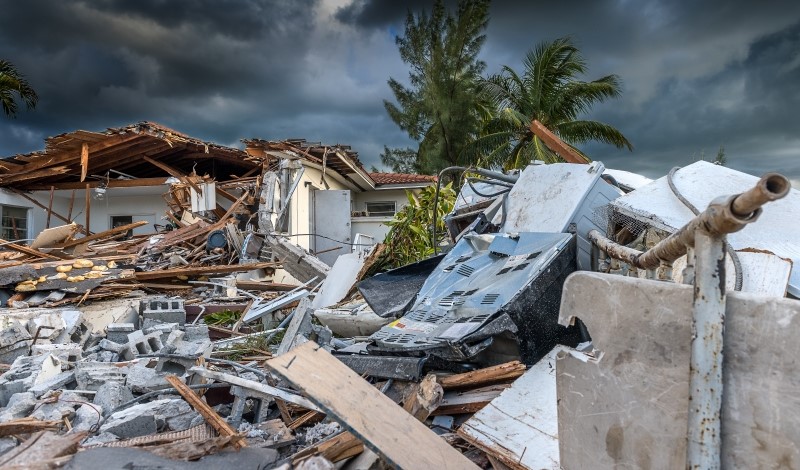
Scholar proposes new strategies for disaster law that focus on proactivity.
As climate change worsens, extreme weather events increase in frequency and magnitude. The United States experiences, on average, a billion-dollar weather or climate disaster every three weeks. Some scientists have estimated that the global cost of extreme weather attributable to climate change is $143 billion annually. Yet, current laws and policies support a dizzying cycle of “destroy, rebuild, repeat,” one that is expensive, unsustainable, and dangerous.
In a forthcoming article, Mark Nevitt of Emory University School of Law proposes a new proactive framework for policymakers to break the climate disaster cycle: “inform, retreat, and suspend.” Nevitt argues that this framework is necessary to safeguard communities and improve climate resilience on a warming planet.
Disaster law encompasses the laws, policies, and procedures shaping the governmental response following a disaster. The 1988 Stafford Act primarily dictates the disaster response at the federal level. Under the Act, a governor, tribal leader, or local authority can request federal assistance following an extreme weather event or natural disaster. The process allows the federal government to grant financial, personnel, and technical assistance to the affected area through the Federal Emergency Management Agency (FEMA) to help it rebuild and recover.
Nevitt contends that the Stafford Act, FEMA regulations, and insurance policies are primarily reactive and fail to account for climate risk. For example, Nevitt notes that federal disaster law encourages building in areas of high climate risk through cheap flood insurance and easily accessible federal disaster relief. Taxpayers foot the cost of the post-climate disaster rebuild, only for those same properties to be at risk in future disasters.
These laws and policies exacerbate what Nevitt calls the “disaster-reconstruction complex,” drawing ties to the military-industrial complex. Poorly designed disaster policies allow the same entrenched real estate investors, municipalities, homeowners, and disaster contractors to profit continuously from disasters. These interests aim to maintain the status quo by downplaying climate risks and fighting efforts to improve climate transparency.
To break this climate disaster cycle, Nevitt identifies three steps that governments and regulators should prioritize: informing and warning the public about climate risks, supporting the retreat of impacted people from high-risk areas, and suspending governmental services in high-risk areas.
First, Nevitt argues that providing accurate and timely access to climate-risk information is necessary. This information would allow people to make better-informed decisions about moving away from high-risk areas. Nevitt offers several ways to make climate-risk information more available. For instance, FEMA should develop more precise flood maps through modeling that accounts for future climate projections and make these flood maps available.
In addition, the federal Privacy Act and state laws often obscure climate risks. Nevitt explains that the Act protects a property’s flood-claim history from disclosure, leaving as many as 6 million U.S. homeowners unknowingly susceptible to flood risk. Nevitt argues that Congress should update the Privacy Act and states should update their real estate laws to improve flood disclosure requirements and increase access to climate-risk information.
Second, disaster policies should proactively work to prepare for retreat and migration away from critical climate zones. Nevitt suggests using a managed and voluntary approach to encourage public retreat that relies on federal buyouts rather than eminent domain, which is risky due to the potential political fallout.
Nevitt also notes that governments and agencies can modify hazard mitigation assistance to encourage voluntary retreat. One study found that the federal government saves six dollars for every dollar spent on federal mitigation grants. The government could leverage this return on investment to fund buyout programs for frequently flooded properties. Nevitt also suggests amending the Stafford Act to condition federal disaster relief on state and local pre-disaster mitigation efforts.
Finally, state and local governments should consider suspending municipal services and disinvesting from areas vulnerable to climate change. Nevitt recommends several changes to implement suspension successfully. One suggestion is that Congress should suspend the National Flood Insurance Program, as it has encouraged coastline growth and subsidized climate risk. Additionally, emergency services, road maintenance, and other government services in climate-exposed areas should be ramped down by states and municipalities and eventually eliminated.
If all else fails, Nevitt adds, Government officials may need to resort to forced retreat through eminent domain proceedings. Although the cost would be enormous, Nevitt observes that a proactive government relocation of at-risk communities before destruction would be far better than waiting for climate disasters to strike.
Nevitt acknowledges that this suspension proposal is politically fraught and legally challenging, especially compared to mandatory information disclosure and voluntary retreat. In addition, any proposal to suspend essential government services must account for climate and environmental justice issues. Nevitt emphasizes, however, that suspension is necessary to halt the climate disaster cycle.
Nevitt concludes by reiterating that federal, state, and local lawmakers must work together to align their disaster laws and policies. By investing in legislation and policies that discourage living in high-risk areas and enable individuals to decide where to build communities, Nevitt is optimistic that the United States can break the climate disaster cycle.



